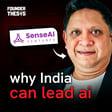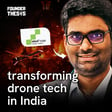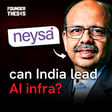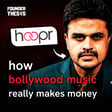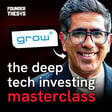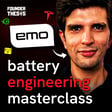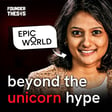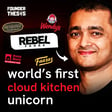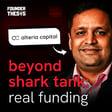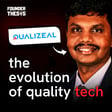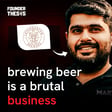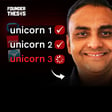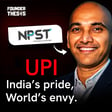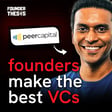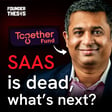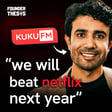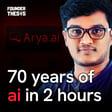Become a Creator today!Start creating today - Share your story with the world!
Start for free
00:00:00
00:00:01

Building the B2C communication stack | Shivakumar Ganesan @ Exotel
A small idea that grew into giant success- Shivkumar Ganesan shares his story of building one of India’s pioneering SaaS companies and the rollercoaster ride of building it into the giant that it is today. Listen on for some amazing nuggets about market sizing, finding product market fit, fundraising and lots more.
Additional links:-
1.AI is changing the way businesses interact with customers: Exotel CEO Shivakumar Ganesan
Transcript
Introduction to Shivkumar Vinesan and Exotel
00:00:00
Speaker
Hi, you are listeners of Founder Thesis. My name is Shivakumar Vinesan. That's a long name. So people mostly call me Shivku. I'm the co-founder and CEO at Exotel, India's largest customer engagement platform.
00:00:26
Speaker
When you are trying to disrupt and bring about massive change, it's good to remember that change happens gradually and then suddenly. This is a pretty good summary of the journey of XOTel. Started in 2011, it was a pioneer in the SME SaaS space in India before pivoting to focus on an enterprise API SaaS product.
00:00:42
Speaker
Till 2020, it struggled to raise funds from investors and then suddenly in the post-pandemic world, it raised more than $90 million and acquired two companies.
The Journey to Entrepreneurship
00:00:51
Speaker
In this episode of the Founder Thesis Podcast, your host Akshay Dutt talks to Shivkumar Ganesha, the founder of XOTel, about his journey of building one of India's pioneering SaaS companies and the roller coaster ride of building it into the giant that it is today. Shivkumar shares some amazing nuggets around market sizing, finding product-market fit, fundraising and lots more.
00:01:10
Speaker
Stay tuned and subscribe to the Foundry thesis podcast to learn about building B2B businesses from the veterans of the space.
00:01:32
Speaker
Many of my friends wrote GRE and GMAT and I did not and something sort of blocked me from doing that. I think I quite like the idea of working in a place and building something and trying to take it to the market and things like that. While you were at BITS Pilani, probably when you were graduating,
00:01:57
Speaker
No, actually, this was after I joined Yahoo and after about a couple of years of working there, which is my first job. So Yahoo also paid me more than what I thought I needed. So I had like, I don't know, two years of runway at that point in time. And I thought, what's the worst that can happen?
00:02:19
Speaker
and I wasn't really interested in doing GRE and GMAT. I had lots of points of view on how products need to be built. I think the exposure that I got at Yahoo was also incredible.
00:02:35
Speaker
At a time when starting up was not a thing, when most people wouldn't even know what startups are, because of my experience at Yahoo, I used to listen to podcasts from the Valley, read blogs like Peckunch, and I think in those days, there was Giga Home, and books by Ram Charan and whatnot. And I used to closely follow the fight between Yahoo and Google on search.
00:03:04
Speaker
I was kind of hooked on to the technology world, the ability that a bunch of people can come together and write some code and change the world. Of course, Steve Jobs was still alive at that point in time. So he was a great guy. All those books and whatever else. And I think that's really how I got started with my entrepreneurial journey. It does look like after about two years of working, somehow I just knew that I was going to start. It was just a matter of time.
00:03:33
Speaker
Okay. So tell me about that journey into entrepreneurship, like from Yahoo. See, I think it was mostly that I had a number of things to say, and I had a point of view about the world. And when I used to go and talk to people, they used to mostly shoot it down, if you will. And somehow I wasn't able to take back for an answer.
00:03:57
Speaker
And then something kept telling me that I should pursue, I should continue on with my thoughts. Maybe I just wanted to prove to myself whether I am right or wrong. Maybe I just wanted to find it out on my own. But that was really how it all got started. So when I was at Yahoo, I used to read these blogs and articles and books and then every quarter I'll have a new idea and then I'll pull somebody over and then I'll pitch the idea to them and then mostly they will, if they are nice people, they'll just say, okay, let's catch up later and then if they are
00:04:27
Speaker
direct people mostly creates a stupid idea. But then that just kept on participating in my life for a very, very long time. And then after about five years, I got some awards and it's that and then so at that point then I was like, hey, you know, it's about time we tried something. So I actually quit Yahoo with my colleague to start off.
The Birth of Exotel
00:04:50
Speaker
My original idea was to build a cheap navigation device for India.
00:04:56
Speaker
Because you had worked on Yahoo maps, so that's the context. I knew a lot about the tech and naturally there was no maps at that point in time for India. So that was what I got started with. Of course, it never really materialized. I think the partner who came out with me eventually ended up becoming an IAS and he seems to be enjoying that. So he was never allowed to be an entrepreneur.
00:05:21
Speaker
I actually ended up joining Flipkart. They were actually a couple of blocks away from my house. So I used to hang out with them and then I spent about six, seven months there, but they were doing really well. But somehow my itch to start something on my own never really stopped. So I actually quit Flipkart even though they met me really well. I was in the right place at the right time. I had a
00:05:43
Speaker
a good amount of stake and whatnot but so then I again started from scratch started a classified marketplace type business where I think if I continued on with it it would have become something like OLX or quicker today and then to enable
00:06:04
Speaker
the marketplace I had to come up with some phone number and ability for people to sell and send SMS and make phone calls and it was like a medium agnostic classified business and so it was a tool I went and spoke to a bunch of telcos this that and then put together a tool that tool actually has what now become example okay and at this time nullity was also there you didn't want to like just take nullity off the shelf
00:06:31
Speaker
So, it was a very strange coincidence. So, I didn't know when I started writing the basic code for Exotel, there was no nolality yet. When I was weeks away from launching the product, somebody actually sent me a link saying, hey, check out nolality. If I had known about six months earlier, maybe I would have been...
00:06:57
Speaker
Wow, it's funny, the way life molds us. So, what made you take the call to shut down the classifieds business? Why did you go all in on the telecom product and not the classifieds?
00:07:17
Speaker
It appeared as though we'd be able to make more money with this than that. So the classified business, I was running it for about a year or three months and then it was mostly I was driving towards traffic and increasing engagement and a little bit here and there. Overall, I would have made some 40% of the business. So there was no actually meaning over a year.
00:07:42
Speaker
monetization way yet because I have to wait for the critical mass to build in. Whereas here people are willing to pay five little pieces a seat and from the get-go and so I was quite attracted and maybe on the back of my mind I also knew that I was running out of my runway so I was like hey you know someone's paying they'll pay for this so let's just focus on this that going and so that's how I inverted away I shut that thing out and started focusing for here.
00:08:08
Speaker
What was your go-to market for XOTel? You had no sales and marketing experience. How did you figure that piece out? Initially, it was mostly my network. So as I told you, I was hanging around with all the startup enthusiasts for years when I actually started almost maybe four or five years. And so I knew almost everyone. So I knew Babish Ramola. I knew the Bunsells from Flipkart.
00:08:38
Speaker
So all the guys who are actually at that point in time starting up, who are a part of the, I knew Sasham from Practo. So those were my initial customers. So I went and pitched the idea to them and sometimes even forced them to buy, neutralized my social capital a little bit to sort of frustrate them into purchasing it.
00:09:01
Speaker
So all works, the entire first 15-20 customers are all themselves startups. That was my initial GTM strategy, was to use my own personal. And what was the problem that Exotel was solving? Like what was the solution or the product?
00:09:19
Speaker
At that point in time, we used to call it one number for your business.
Growth and Market Insights
00:09:23
Speaker
So we said that everybody needs a website and a number. And so may that number be Exotel's number. And then we'd enable both SMS. There was no WhatsApp yet. So we enabled both SMS and phone calls. And then so you can now receive incoming calls for support. You can make outbound calls to sell your product. You can put this number on your listing card on your website.
00:09:47
Speaker
And then you can set up IDR, this, that. So that was what was the original product. So from this one number for your business product, how did you reach to where you are today?
00:10:07
Speaker
and like what i'd like to hear also is in multiple facets like so far you were bootstrapping it right so you would have realized at some point of time that you need funds to grow further and you know to really scale it up so like could you tell me about that.
00:10:23
Speaker
So, step number one, once I knew that a few customers were about to buy, I got my co-founders in. Again, I dapped into my network. One is my college friend, one is my ex-colleague, and one is my college junior.
00:10:42
Speaker
Then we started building and between the four of us, obviously we knew how to build, write code and one of them was also coming from a, you know, he was a part of the national entrepreneurship network. So he also again had a marketing type, at least started marketing type experience.
00:10:59
Speaker
and so we quickly sold about 50-75 customers then we raised a little bit of money from Mumbai angels and bloom at that point in time even for two and a half throws it seemed like a big deal and then we we actually even did a party we called everybody
00:11:18
Speaker
And was it easy raising that first round? First round was easy. In fact, I had like three term sheets and in fact, there was actually a sharp tank before the sharp tank. It was running in ET now.
00:11:41
Speaker
I was a part of that and we actually take money on TV. Up until this point we were still hot property.
00:11:56
Speaker
And then why were you hot property from like a macro perspective? Was there like a back on cloud terra funny as a sector which made you hot property or was it like the founding team was very impressive or was it like you had great traction? Both. See, I think in general, finding is very important in starting businesses.
00:12:21
Speaker
So there was a time for starting cloud telephony businesses and that time was maybe five, six years ago. And then there are, for example, many companies may have started drone businesses. There was a time to start a drone business, but because of regulations, et cetera, in India, for example, unfortunately touch story didn't really pan out.
00:12:43
Speaker
Now is the time for EV businesses. Now is the time for EV business. I don't know, maybe something in metaverse. So Bitcoin used to be, I think, three, four years ago. So there's always a timing issue when people always start businesses congregated around those waves or patterns that seem to be emerging from the market. So at that point in time, there wasn't, see,
00:13:08
Speaker
See, this is good. By the way, 2010-2011 is also a very different time. So there was no smartphone yet. I think around about this time, when we raised our first round is when I think WhatsApp, I just heard about WhatsApp. And I think about six months earlier Steve Jobs demonstrated his iPhone 3.
00:13:28
Speaker
You're still at very, very early status. So there wasn't anything to build in technology other than website and communication systems. So those are really the only things that what now we make on is B2B SAS.
00:13:45
Speaker
Okay, got it. Okay. So yeah, continue with the journey. So you raised about two and a half crores you said from that ET buddy, the TV show, TV show and then it scaled that up to maybe about 300, 350 and small and medium companies. It was supposed to be DIY inbound content marketing through and these are all unheard of at that point in time, by the way. So we were like, we were probably
00:14:12
Speaker
doing more inbound leads than anybody else in the country has done in time. We didn't really have lead on the street. So we were trying to build a classical SaaS company from India for India. So this is not even like the fresh work story, right? So this is actually from India for India.
00:14:30
Speaker
But that didn't really play out for good reason. DIY didn't work at that time. The customers would not have been savvy enough to use a DIY service.
00:14:44
Speaker
That's correct. So, most of the time at that point in time was still startups and then obviously those guys loved it. But I don't think people beyond the startups who are really interested in or knew about DIY or what SaaS is and how to buy it and things like that.
00:15:02
Speaker
Secondly, I don't think SMB India was a large enough market. So I think even my pitch was slightly flawed from the get-go. There was no way I could have built a billion dollar business using the pitch that at least I showcased to people at that point in time. So people were like, hey, this is all fine, but can you tell me how we are going to cross above 50 crores of revenue, 100 crores of revenue. So I didn't really have an idea.
00:15:25
Speaker
so naturally in the exam yeah yeah pitch was that there'll be millions of like mom-and-pop shops like a coaching center or a boutique or a beauty parlor who would sign up for this number like that was the reason okay I think was too early the the market was definitely shallow you know
00:15:49
Speaker
I think we could have scored maybe 500 rupees a pop, but that was more like so-ho, small offices, very, very small. It's fine, but it's not going to be a meaningfully large business. So I had a failed CDSA attempt. Then a couple of years, one year after that,
00:16:13
Speaker
We pivoted into enterprise. So we started selling the API platform, which we always had. So then Ola adopted us, then Uber adopted us. And then somehow we discovered what we internally call as the last my connect market. So we became the backbone through which
00:16:34
Speaker
drivers and passengers, teachers and students, doctors and patients, buyers and sellers, all of these people started talking to each other through the cloud and so it was an accidental market that we ended up in. Because we always had the API platform because it wasn't even like we were trying to build anything, we always had it so we had to just expose it and people started using it.
00:16:55
Speaker
and just help me understand what exactly is this product you're talking about like it is what you know Exodel for so you know number must be so call comes from your Uber driver it comes from an online number and things like that right so you would like to call a seller in just dial the number that you see there is not the number of the person whom you're actually dialing so people are using it for protecting privacy
00:17:23
Speaker
for tracking the calls, for call recording, for compliance, a whole bunch of things, quality assurance. So that really took off.
Impact of COVID on Exotel
00:17:34
Speaker
I used to joke that there was a point in time when we used to make more money off of an owner than Ola itself.
00:17:43
Speaker
We were making about 2 rupees for Ola Ride. So, of course all of that is now history. So, I'm happy to share that apart from venture capitalists and many companies like GoDaddy and folks like this, Exupan actually is the unsung hero of the Indian startup ecosystem.
00:18:11
Speaker
So we've actually powered practically any startup that you can now think of. And I'm very happy to share with you that you and all the listeners, you're all customers and users and beneficiaries of agricultural services. We've actually, perhaps if I'm not wrong, close to a board, little less than 20% of India's population today.
00:18:36
Speaker
like I don't know 250, 300 million people have used Exotel's services so far. So that's quite massive. Amazing. So like every time you order food from like a Zomato or a Sugi and that call transaction or like looking for business is not just style that transaction and Ola over of course, all of these are like where Exotel is working in the back end. That's absolutely right.
00:19:01
Speaker
At what kind of revenues did you do then? Like once you discovered that this API business enterprise plans. So I think we took it all the way to about 75 million strikes top line actually. And then which year was that? This must be 2018, 2017, 2018. So you were just going about, by the way, there was actually one more attempt to raise funds.
00:19:28
Speaker
And because this was obviously growing quite well. And so again, I went and pitched. But again, I wasn't really able to showcase how we are going to build a billion-dollar business because mostly people would be like, what after Nambamaki?
00:19:41
Speaker
what after it what what after keep to call right so then I wasn't really able to paint a large picture and so that also again ended up becoming a failed attempt so the click to call was what like you could enter your number on a website and do click to call and then a call would come to you and come go to the business and connect both of you something like that
00:20:04
Speaker
I'm not the most basic version of my talk about click to fall i mean more like let's say you have a relationship manager at icic i.
00:20:13
Speaker
and let's say he wants to now get in touch with you. He's not seen people no longer go to office, right? So there is no like an Avaya phone or whatever it is that people used to have. So they actually click on the CRM somewhere and then using that they actually talk to you. So it sort of becomes like the virtual call system for employees of company. Okay, okay, okay. Like a cloud, let's see passes what this is called, right?
00:20:40
Speaker
I don't know, maybe you can call this Cloud BBX, you can call this Cloud Phone System. CPaaS is a generic term that people, communication platform as a service, is a generic term that used to describe the overarching infrastructure of the platform using which applications like this can be built.
00:21:02
Speaker
Okay. Okay. Okay. Got it. Okay. Okay. So yeah, that fund raise then didn't happen. Like even at $75 top line, you were struggling to raise funds. I mean, it's like, was it the valuation also that you were expecting a higher valuation? No, I just think it's, I don't think I was able to demonstrate to people,
00:21:28
Speaker
clearly enough as to how large this can be, this can become. So I should always go and tell people, this is what we are doing, right? But I think most investors are looking forward to understanding how big can this become. And maybe I wasn't able to...
00:21:43
Speaker
Maybe I wasn't able to visualize it myself, and I don't think I was, suddenly I was not able to help them visualize it. So people always looked at Exurban as a good technology profitable business, which makes a little bit of money. I'm sure they can make 100 crores, 150 crores, 200 crores top line, but after that one, right? So I think that's the way, and mostly I think it has a small impact.
00:22:05
Speaker
Okay, because like WhatsApp, etc. are in a way substituting what used to happen through regular telephone calls.
00:22:18
Speaker
Correct. Unfortunately, in my case, WhatsApp ended up becoming an argument point against our business because most people at that point used to say that WhatsApp was a takeaway of business, people removed to digital channels. All of that is happening. I think what truly changed the game was COVID. I don't know why that got me and everybody else excited.
00:22:48
Speaker
So let's say, let's take an example. So let's say you want to give your car for servicing. Four years ago, you will take the car to the service station in the morning, tell them what your problem is, take an auto to the office, come back in the evening, pick up the car and come home. Correct? So this is what you use. Whereas now there is a CRM integration.
00:23:08
Speaker
There is a phone call on a WhatsApp message that comes and says, hey, it's time for you to send the car for self-sizing. Then you say, oh, yeah, whatever. Then there's a guy who comes and then picks the car up and goes back. Then the advisor actually does a video call with you to show the scratches or spiometer or whatever it is that he's going to do. Then he sends a job gone on WhatsApp. Maybe you make the payment on WhatsApp.
00:23:31
Speaker
and then in the evening the car comes. So what used to be a zero technology business transaction has now ended up coming a few WhatsApps, one video call, one CRM integration, one chatbot and
00:23:47
Speaker
So this is the big deal. So we are now at the cusp of converting the world. So that's the big deal. So we now are sitting at the possibility of powering practically every business transaction that's going to now happen in the world. And all of them is going to be a hybrid of remote and in-person going forward.
00:24:09
Speaker
We all know that it's because of COVID and the fact that people are habituated into buying remotely now. So there's no going back. And I think this is really what gets me excited. I know earlier I used to think of Exodel as the backbone of the startup ecosystem. Now I think of Exodel as the backbone of every ecosystem, every company, everything in this transaction that potentially happened.
00:24:30
Speaker
All of them involves some SMS reminder, some WhatsApp, something, some phone call somewhere, some chatbot, some recognition. So I think that's the exciting part. I think I saw this. I think investors were able to see it. And our numbers were also showing it. And I think that's really what lifted our business from what looked like a they'll get to 200 crores and then it'll be a lifestyle business to
00:24:56
Speaker
Hey, this can actually be potentially a couple of billion dollars top-line revenue company and go public in India. So tell me the journey of how you figured this out. Like you got that second time rejection when you tried to raise funds in 2019. How did that lead to you discovering this new product market fit and this pivot which took place?
00:25:24
Speaker
I mean, we didn't really actually discover much. I think, see, just before Covid, we were actually going to banks and then we were trying to sell our virtual relationship manager solution, which is what I guess, how do we now get stock brokers and relationship managers? How do we now get one-on-one interaction going between them and the customers? Now, everybody liked it. They wanted to buy it, but there was no
00:25:51
Speaker
There was no impetus for them to sort of adopt it right here, right now. So these used in long protracted conversations. Slowly we were making headways and I think that's how life would have gone. But the relationship was like a chatbot.
00:26:08
Speaker
based solution like you could start chatting on your ICICI bank app for example that what is my balance and it would like fetch that through a system integration and if you wanted to talk to a human being then it would enable that conversation also like something like that or like something like that but we weren't doing chat yet so this was still the
00:26:30
Speaker
phone number using which you can call your relationship manager in HDFC bank. That guy can now call you back on the same number, but this is actually not a real phone. So this is actually a virtual number and you call it, you go to his cell phone, we call it, you come to your cell phone. So it is still an extension of the original demo asking type idea that we had. Yeah, but yeah, okay, good, good, good, good, good, good, good, good, good, good, good, good, good, good, good, good, good, good, good, good, good, good, good, good, good, good, good, good, good, good, good, good, good, good, good, good, good, good, good, good, good, good, good, good, good, good, good, good, good, good, good, good, good, good, good, good, good, good, good, good, good, good, good, good, good, good, good,
00:26:53
Speaker
Right. It solves the problem of attrition, like your relationship manager moved on. Like in my case, I still have numbers of like relationship managers. I had two, three years back on my phone. So it solves that problem because now the number doesn't change. A new person can cover them. Correct. Okay. Okay. Got it.
00:27:13
Speaker
So, this was how we were going to get into BFSI and it was going to happen very slowly. It just happens that overnight everybody had to go remote and once they lost access to that phone in the desk, then every BFSI company wanted to know about this, right? So, you know, and if you think about it, BFSI is about 40% of NFT. So, that's the single largest market for most software companies in India.
00:27:42
Speaker
So suddenly we had like too many leads and we couldn't pursue and then it was a very busy COVID time for us. And then of course there was also COVID helpline numbers and lots and lots of requirements actually because everything was remote.
00:27:56
Speaker
So that's really what took off. So this is the reason why Zoom took off. This is the reason why Twilio took off in the US. It's the same reason why we took off. Many other communication companies also took off. Road War buys took off. So I think it was a moment in time where everybody suddenly saw the power of what these communication systems, these engagement technology can do. And I think it really just
00:28:21
Speaker
and we were like there at the right time and it was just hard to mix. So there was nothing really for us to do. We had to just ensure that you can well. You were inside, inside. Amazing. Okay. And what did you do as you're toppling that from the 75 crore? What did that become?
00:28:37
Speaker
Last year, the platform business ended at about 200 crores of Doppline. We also ended up acquiring two other businesses. There was the contact center business of Amayo, which was also doing about 100 crores of Doppline.
00:28:52
Speaker
We also acquired an AI company and then now we're in the process of putting it all together.
Strategic Expansions and Acquisitions
00:29:01
Speaker
So we'll end up with about 60 million dollar type ARR. So ending in the dollar rupee is fluctuating towards. I don't know any stats right now but somewhere in the 60 million type ARR now.
00:29:19
Speaker
So this is still like a virtual number service which started selling like hot cake. How did that expand into what you explained to me, like something which powers every interaction with a customer for a business?
00:29:35
Speaker
So I think it was mostly, this is a place where I think that I was also dig by bit, so it was not like we were just sitting there watching the wave play. So, something about the ally, we were actually talking about, see, if you think about contact center is the single largest use case on the CPAS platform. And so, we had the platform, we had all the APIs, we didn't really have the ability to actually sit and build out the contact center, so,
00:30:03
Speaker
I went and told him, hey, you know, what if you join hands and, you know, let's bring emerging markets first cloud contact center. And so that was the thesis. Originally, I attempted to do that purely on an equity basis. So we were trying to see if we can do like a stock swap. But unfortunately, these kinds of deals don't happen without cash on the table. Because Abhiya had also addresses on the capital, like their address.
00:30:31
Speaker
Absolutely. So then I had to wait for my first round from A91 to happen. And then basis then I went back and they were actually talking to somebody else for an acquisition. Somehow I went in and then pulled the deal out of the lion's mouth. So he was very, very exhilarating, quite exciting times.
00:30:57
Speaker
On one side, of course, you're all pissed about COVID itself, but I was actually doing the work of my life during COVID. So there was one year in which I had raised, just in one calendar year, I had raised four rounds and did two acquisitions. All in a set of helmets. So we were announcing that there'd be quarter.
00:31:18
Speaker
Wow, amazing. The first round you did was about 5.5 million, then 16 million, and then there's a small 1 million round, which is probably an extension, and then a 35 million series C, and then a 40 million series D, correct?
00:31:39
Speaker
Wow incredible and like this was on the back of two things i guess one would be the trending revenue numbers because you you're like the platform core platform was selling like hotcakes and second was this new vision which you had of building a overarching platform to power all customer communication for which you wanted to acquire amio
00:32:05
Speaker
So I figured that, so there was the one key observation was that, okay, so I've always had the vision of bringing a pure cloud contact center, seamless, easy to use, good to use cloud contact center for emerging markets right from the get go, because that's how it happens in the US and I'm like, how come it's not happening in emerging market? There's someone's going to solve it.
00:32:26
Speaker
So that vision was always there. But the observation was that the largest segment, which is a BFS segment, now has started adopting cloud and AI in a big way since COVID. And that was a big motivation for us. And we also saw that people wanted to buy more and more channels and products from the same vendor so that they actually have only one person to sort of deal with.
00:32:49
Speaker
And now on the motivation behind the full stack customer engagement platform, which is to say that we will help you handle all the channels. We will also have the applications that are built on top of these channels. And we'll be able to also ensure that we have keep all the data in the same place so that you're able to know
00:33:11
Speaker
understand your first-party data a lot better. You make a call from the call center, you'll be able to use the API to download it, and you can use it to train the chatbot so that it responds better the next time. I think that integrated suite of products, we saw that customers wanted something like that.
00:33:29
Speaker
So that was the in observation and and so to by bringing example, I'm even called no togethers. So we now converted what was a customer communication platform into a full stack customer engagement.
00:33:45
Speaker
What does Avio and Cogno add? What is the Avio product? Avio is a contact center product. They were well known for building, they were, I think, maybe the third-largest contact center software provider in India and in emerging markets. So by acquiring them and then buying... What does a contact center software look like? Can you just describe what it does?
00:34:09
Speaker
Nothing. I mean, every time you call, I'll call some, let's say Amazon for some, it's going to the contact center. Somebody is calling you and saying, Hey, it's time for you to make your credit card payment. That's coming from one bank center. So these are all contacts. You were already doing this, right? Like the single number for a business is the same thing. Like, like how is it different from what you were already doing?
00:34:33
Speaker
This is enterprise-grade so ours was more like a customer communication management SMB SaaS product. I was on one side and then we also had the APIs which were not really anything when they were this API so you can build anything that you want but you still have to build it from scratch but this is actually like a
00:34:53
Speaker
Trueglue Enterprise Contact Center. So it'll have features like skills based on predictive dialer, workforce optimization. So some competing products in the US would be 5.9, 8 by 8. There's Ozard Dell in India. There's Ozard Dell in India.
00:35:11
Speaker
So this is actually a segment on its own. So with a specific software for that need. So the contact center then happens to be the largest use case of a CPAS platform. So that was the under behind.
00:35:28
Speaker
getting AMIO and then making it work with the Exotel cloud so that we now have an integrated suite where the software is still AMIO but the backend, the network, the SMS, the WhatsApp, everything is powered by the CPaaS platform. And SMS and WhatsApp also was added by AMIO or you built that in house like the SMS WhatsApp capabilities.
00:35:52
Speaker
SMS was originally in the OSTO in the exotent. Amio had the WhatsApp, what should I say, partner account and then we ended up building the APIs around it. So they had like a application on it. So we ended up extending that and converting it into APIs. Now we are expanding to other channels like, I don't know, hopefully we'll add Instagram and listen to that, Viber and what.
00:36:20
Speaker
Okay, like Instagram from a messaging perspective, like to send DMs to customers. That's right. To respond to customer queries, support queries, to send, you know, we may even include things like push notifications, email. So these are all other more and more channels. So API is what we all of these things. Okay, okay. And what is Cogno at? Like, why did you acquire Cogno?
Innovations in Customer Engagement
00:36:49
Speaker
Cognos is a leader in chatbot in BFSI. As you know, the world is moving towards a couple of things. One is more and more chat-based communication systems are coming in the place of voiceness systems. People don't want to call up contact center numbers anymore, so they just want to send the chat.
00:37:14
Speaker
and that they wanted to be asynchronous. So you can reply back whenever you have time and I live with my life, live on with my life. And now that once it is chat on the other side, you could now potentially hook up a bot so that can hopefully handle simple queries. So it's a win-win for everyone. It's a win for the customer because you get instantaneous response. It wins for the enterprise because it reduces cost.
00:37:40
Speaker
So pretty much any chatbot that you encounter in any bank, there is a very high chance that it is actually a combo bot. So then our endeavor is to now sort of bring in BZ capabilities into our enterprise contact center product.
00:38:00
Speaker
and then bring in the cloud capabilities and then so now we will have a world-class contact center product that pretty much has anything that you can think of, multi-channel, AI-enabled, cloud, highly scalable, reliable, that would be a winner.
00:38:22
Speaker
So I want to understand the AI enabled tag. I think a lot of businesses use this tag very casually of AI enabled. What are the things which you're using AI for? What is the way in which it is adding value to the customer?
00:38:40
Speaker
So there are a few things that RAI can do. So you can now point it to FAQs, to your website, to the knowledge management system, and then it will now create all of those details, and then it will now try to build some topics. And then you can hook it up to a WhatsApp number, or you can put a chat window on the website. So when somebody comes in and then they opens and says, I want to know more about how you all dispose personal loans.
00:39:09
Speaker
So then the tag bot already knows the answer. So it will now respond back with, here's what I know about the thing. Would you like to have more information? If so, send me a yes and I will connect you to an agent. So that's what the bot right now is mostly a services query bot. That's one.
00:39:32
Speaker
The part, we've also now hooked up a voice component to the same NLU infrastructure. So technically, very soon, and we actually have a few POCs running already, you could now also hook it up to a number. So if you call in and then, like how Sundar Pichai gave this demonstration of, I think they call it IDA, interactive voice agent, maybe nothing as dramatic as that, but something simple enough, we'll be able to sort of deploy, especially it'll be useful for outbound.
00:40:01
Speaker
so there's a specific intent with which the bot will call you it might now tell you hey you know it's time for you to make the payment so those kinds of things right now they'll be like pre-recorded conversations IVR calls which is not fun now can we humanize that a little bit more and can we now make it more personalized so it can do that
00:40:21
Speaker
Soon enough, hopefully we'll be able to now get the bot to analyze the calls and then it can now tell you the sentiment or whether the call was a good call or a bad call so it can now provide insights and analytics around conversations.
00:40:34
Speaker
Uh, maybe it could even suggest to the agent, uh, somebody's ordering a gift. It can now say, Hey, it's time for you to upset like gift trap. Uh, and then maybe the agent can say, Hey, you know, do you want to also gift trap the package? So it could be, uh, assisting the agents to doing their job better. Uh, so those are all some of the features and functionalities.
00:40:55
Speaker
Okay. And what about the act of raising funds? Is there advice you can share on that in terms of what is the way to reach out and what is the way to build credibility and what kind of investors to target and so on and so forth?
00:41:15
Speaker
I think in this case, I think it will be dependent on a person's style. Well, this is what I did. So I actually always said things as it is. And so that's actually both my boon and bane. So I never used to hype things up nor did I ever
00:41:34
Speaker
paint a bleak picture. So I used to always paint that light picture and I think that increased credibility. So even today many people may not have funded me but they'll always pick up the call if I call them. They'd like to know what is it that I'm off to. That really worked.
00:41:56
Speaker
Second is, if you think of fundraising as a journey rather than an event, I actually kept in touch with people even when I was not trying to raise funds. I used to generally catch up with people, I'd tell them give them updates and build relationships and I think people like to see that you are around and you are interested and you are persistent and you are going to pay no matter what against all odds.
00:42:19
Speaker
And so I think that also happens. So, you know, from A9P1, I've actually known Gotham for like over a decade. And he's seen me build a company from zero to everything, right? So there's a lot of credibility and trust that gets into it. So he knows that I'm not going anywhere. And if it is possible to win, I'm going to be here and I'm going to try to win.
00:42:39
Speaker
I think these are two thoughts I'd like to leave. People also try to convince investors to invest, which is the wrong way to go about it.
00:42:54
Speaker
I usually think that one must ask oneself, what is a substantial sum of money? So let's say for you, maybe 20 lakhs is a substantial sum of money. Now I'd like for you to write a business plan and I'd like to ask you, would you put 20 lakhs of your money into this plan?
00:43:12
Speaker
So it needs to pass the, you being invested in your own company, best first. And then once people start to think of it that way, when it's no longer about convincing the investors, it's actually about building a business and then raising money becomes a part of that.
00:43:29
Speaker
I mean, these are all very, you know, basic things that, you know, first time entrepreneurs actually make these mistakes, but once you sort of again, then you realize that raising funds is not the end game, right? It's just a part of another end game. The other end game, the primary objective here is to build a business. So, amazing. Okay.
00:43:54
Speaker
Is there a risk of you losing your frugality? This frugality is an assumption I'm making. Considering that you were not able to raise funds for the first 7-8 years, you must have, by force, been a very frugal organization. Do you see a risk of that changing?
00:44:13
Speaker
Not only is there a risk of that changing, in fact, it has already happened. So we've actually taken three profit making companies and we've converted into one massive loss making company. And then now we are working right now to bring it out on a shithole.
00:44:32
Speaker
Go back to what we were doing and that's okay. I think when you have the money and if you don't spend then what's the pipeline. So suddenly you do experiments, do experiments, make some bets and that's what we try to do and some of them will run, some of them will not but ultimately you still learn and then the hardwiring on I won't say frugality as much as sustainability
00:44:59
Speaker
Actually, I wouldn't even say that. It's ultimately the whole. The objective of a company is to make profits for the shareholders. So that's the stated whole of the institution. So at least in my mind, I'm not mincing that. So ultimately, the question that I'm asking is how do we add money to customers and how do we make money for shareholders? Those are the only two things that matter. Everything else is bullshit.
Pricing Strategies and Enterprise Sales
00:45:29
Speaker
I want to understand a bit about your pricing journey and what you must have had to relearn pricing also when you moved from SMEs to enterprise customers. Tell me about that. How did you figure out pricing for the SMEs and then how did you again figure out pricing for enterprise customers? When we started, I think it was all over the place because there weren't too many competitors and
00:45:56
Speaker
So we did whatever we did. But I think as the industry matures and as there are more competitors who come in, frankly, there's not much you can do about it. So the access of pricing will be well established in the market. So for example, you have to sell SMS on a per SMS basis. You can't do anything else.
00:46:16
Speaker
you have to sell a contact center on a per seat basis. So they're all well established practices. So the axis of pricing is interesting only when you're launching something new. For example, in the case of bots, one could now say, can we just charge them per month overall? Can we charge them on a per conversation basis? So we are doing some experiments like that. So I think the first way to think about pricing is what is the axis of pricing?
00:46:43
Speaker
And as entrepreneurs, our goal is to ensure that the axis of pricing is different from the axis of cost.
00:46:52
Speaker
So, if you are now purchasing something and then you are adding a little bit of masala and you are selling it at the same axis of pricing, then it becomes a cost plus model and so the company begins to think in the cost plus way and then margins ultimately will be squeezed one way or the other because people will now ask questions about how much value you are actually adding to the masala that you are adding.
00:47:19
Speaker
Instead, my recommendation for everybody would be to ensure that your input cost is on an axis of pricing that is different from the axis of pricing of your output or the sale price. So that will ensure that there is better margins and then there is better sustainability. Can you give some examples of this?
00:47:41
Speaker
So, I think, of course, I'll give you my industry example. So, there's a company called Attentive in the US, which actually purchases SMSs from CPaaS companies. Of course, not a per SMS basis. But they actually charge the end user as a percentage of the GMV that is generated because of the SMS market.
00:48:07
Speaker
So they're actually saying, don't care about how many SMS's that I spend, but I'm going to now track how much GMV I brought to you and then you give me a share on TV. Well, amazing.
00:48:19
Speaker
which would create an incentive within the organization also to that masala which you put in, you need to make sure that part of it is also reducing the amount of input you need to achieve the same output. Can you get that same GMV increase in lesser number of SMSs, thereby increasing your margin?
00:48:38
Speaker
Your ability to increase your margin is much more in your hands as opposed to a cost plus model where your customer also knows it's cost plus. He also probably knows that, and especially with enterprise customers, they would already be aware that this is the cost and this is what your margin is. So that constant pressure to reduce your margin you would be facing. That's really right. The second key insight is
00:49:04
Speaker
You know, large enterprises do not have a constraint in terms of budget, actually. So long as they don't have the right stakeholder, they actually have the money to make the purchase. So, you can actually, first of all, price it more than what you think, especially if you're coming from off of an SMB background, you can actually charge more, much more than what you think you can charge by number one.
00:49:28
Speaker
And then you should, of course, they will be demanding quality a lot more because it will be business critical for them. So in DFSL, you can't have unreliable and non-secure products and stuff. So you should now instead focus on building more quality and building better relationships and having more people with their services bent of mind, trying to understand what is it that they want. And they'll be willing to more than happily pay for all of these services.
00:49:57
Speaker
So, so that's one and secondly, it's completely fine for you to bake in like a yearly contract cost increase. I think these are some practices that most people who are coming in from an SMB background, you know, they don't really think of these kinds of things, but actually, this is all quite standard in the enterprise. So Salesforce, I believe, has like a 10% yearly cost increase baked into the contract. So, so these are some
00:50:24
Speaker
quick thoughts that came to my mind that I wanted to share on pricing. So, you know, in the long term, can you like break down the economics of the business? Like, what kind of pricing would you be doing? What would be your cost? What would be your margins? I mean, today, maybe, as you said, it's loss making, but what do you see it being? Like, what's the ideal state? Like, what kind of pricing, margin, costing, etc., that makes
00:50:51
Speaker
Unfortunately, now the business has become a little bit complex. So I won't, because now we have like some seven products that we are selling. And each one of them have their own pricing access and marketing profiles and things like that. So it's a little bit like an Apple Watch video marketing profile.
00:51:12
Speaker
When I said that, I think the ideal case scenario for us would be something in the 45%, the type gross margin profile and 15% type with the profile. So this is what we are working towards in the three to four year timeframe. Okay. And what percentage of your revenue comes from enterprise?
00:51:33
Speaker
Almost 80% of it. Do you see opportunity there to create more products which would appeal to SMEs and so on? That market is not deep enough.
00:51:53
Speaker
Probably is interesting now, but actually we've crossed that bridge now, so I don't want to... Right now, whatever something is working, so I just want to build more on top of it and I don't want to go back. How did you change your go-to-market DNA? The DNA for selling to SMEs would be, as you said, DIY and inbound leads kind of a DNA. How did you change that?
00:52:20
Speaker
See, initially there was one person who said, we should do an enterprise and then I'm going to show it to you guys how to do it. And then we allowed him to do it. And then he thought one customer, he brought a lot of customer. Then we had the ranking customers that he got it like BFSI customers.
00:52:36
Speaker
No, this was actually the Uber, for the API business. And so pretty much he became like the enterprise head and ultimately he became the entire sales head. So that's how it originally happened. But fortunately for our other two businesses, so Cogno started off by setting to larger enterprises and he has his own story and that's also a very interesting story.
00:53:01
Speaker
And then Ambedo also had an enterprise outbound sales portion. So finally when we brought it all together, we actually had the entire gambit of things. So we had outbound marketing, AVM, you know, Street on Street, inside sales, SDR. So we now have like a full-fledged, full-blown, you know, David, we have that team. So we do everything.
00:53:22
Speaker
Can you help me understand what is an enterprise sales org structure like? What are these various teams and how do they contribute?
00:53:34
Speaker
Well, at a high level, there will be a marketing team and then there will be a marketing team and a sales team. So, marketing by and large will be responsible for talk leadership, brand and positioning, events, those kinds of things. We also actually have the SDRs, the sales development representatives also reported in marketing.
00:53:59
Speaker
So they do a bit of full calling, they do a bit of research, they do account mapping, they reach out to customers, and they also call it ADM, account-based marketing. So that also actually falls under our mounting charter. And it also has communications, PR, content, and then there's also, of course, an inbound motion. So on the website, the asset,
00:54:25
Speaker
the ads that we put and then the entire conversion from the websites, all of that. Then we have an inside sales team which actually qualifies these leads and then convert the opportunities and then adds it to the CRM. So this is all sort of in the marketing embed.
00:54:46
Speaker
And then once it becomes the sales accepted lead or SQLs, if you will, then it's sort of part of the funnel. So the sales team itself can further be split into either geographies, clusters, or industry, or even product. In fact, we actually have a matrix of clusters and products.
00:55:07
Speaker
So we have people focused on BFSI, on startups. Sometimes we actually also have regions focused in the Middle East, focused in India, focused in Southeast Asia. And then we also have GDM specialists who are focused on products. So there's a why specialist, there's a messaging specialist, there's a WhatsApp specialist.
00:55:28
Speaker
and then so it sort of becomes like a three-in-a-box sort of modules so and then they work together to sort of create the GTM strategy, the motions and actually identify the apples mapping it when you're selling well okay and is there something from which there was already a playbook or did you have to like figure this out on your own or
Organizational Structure and Hiring Philosophy
00:55:51
Speaker
So this is now evolved over time. So we also have a customer success team earlier, we then converted into a customer experience team. So we've actually also experimented with a whole bunch of stuff, but this is basically the knowledge that has been assimilated from three different companies, the good and the bad, all of it coming together with a little bit of external consultants coming in to help. So it's a combination of multiple things. And I'm not even trying to say that this is actually going to be the
00:56:20
Speaker
I think it will continue to evolve even further. So it's a journey. Speaking of assimilation, that's one of those things which a lot of startups are not able to manage so well. Is that one of your concerns, like you acquired these two companies?
00:56:45
Speaker
How would the combined organization work as a cohesive unit? How would you look at the cohesive culture and the practices and so on? What do you think? I think we've nailed it. I'm actually very pleased with the way. I think 80% of everything is working fine. People are all doing their jobs. The first year of the acquisition, all three companies actually hit their numbers.
00:57:10
Speaker
And then we've not had a large amount of chat or anything like that people have come together and it is still on the ground of course a little bit of Challenges, but I think by in large we've managed the show very well And how did you nail it like what's the secret of that success? I think I think most two things one one is my own person ability so I
00:57:40
Speaker
My superpower is being nice to people. Okay. Amazing. So, why wouldn't we want to hang on with a nice person? So, I think that's one issue that superpower is listening. My partner.
00:57:58
Speaker
So he also did another couple of tactical things that I think really cemented the organization. So he actually now ensured that everybody got the same salary no matter which company you're from. So there are a couple of these very early things that we didn't really cement the trust.
00:58:21
Speaker
This was number two. I think there's also quite a bit of strategic alignment. So this was not like some random company that we picked up along the way. You know, I actually discussed the vision with Sachin Bhatia, with Dhamban and then they saw it, they questioned it and then they exactly knew what we are trying to do and why.
00:58:41
Speaker
So I think there's a lot of strategic treatment. But more than all of this, I think we gave the time that was necessary. So we just really rush into pulling things together. And I didn't like forth. In fact, I actually took step backs multiple times and said, we are not ready for this yet. Let's take a step back. But Colmo is still running separately. It's a quasi together mode. But I think we took the time to
00:59:06
Speaker
do this and so that everybody had the time to go through the change if you will. I think these are some of the reasons why I think we had succeeded so far.
00:59:20
Speaker
Like are the founders in, like now co-founders at Exotel, are they in it for the long haul or like what is the founders of Cogno and Sachin? Yeah, absolutely. That's the surprising part. Both Sachin, certainly Sachin and maybe Aman as well, both of them think of themselves as also founders. In fact, they are also.
00:59:46
Speaker
So I think that they think of this as their own company and they are in it for the long haul. They've actually both made more money than I have actually. But that's not really stopped them from continuing to pursue their dreams. So it's all great. Maybe he's gone lucky. Amazing. Tell me what it takes to build a 900 people company and you know to build it successfully.
01:00:14
Speaker
Actually, I don't think anybody should attempt to build a delivered people company. I am myself not pleased with the number of people that we have. It's a pain. It's a pain to communicate, to keep all of these people updated.
01:00:30
Speaker
to ensure that they are all aligned, the overheads are humongous. What should always strive towards having a lesser number of people for as long as they can, because the largest number of people, bureaucracy is an automatic consequence of it. And that's just us, because it really drives good people away and it breeds conformance, it breeds compliance and
01:00:58
Speaker
such an institution will never do anything breathtaking. So one should always fight the intuition to hire more. In fact, it's the other way around for me. I'm actually asking, how do we now do more with the people that we have? So I think that's the more right question to have. So don't try to hire actually. So hiring should be the last resort.
01:01:23
Speaker
Wow. That's an amazing insight. I have yet to hear that from someone that don't hire. Wow. Amazing. Okay. But otherwise, like, you know, how do you, I mean, running a 900 people company is hard. Like, how do you build like the leadership layers and, you know, what is the way in which decision making happens? How process oriented are you as a company? Like help me understand some of that stuff.
01:01:50
Speaker
So, actually, frankly, I don't really think about the 900 people at all. I only always think of the people who report to me. I had 6-7 people reporting to me when we were a two other people company. I still have only some 6-7 people reporting to me when we are a 900 people organization.
01:02:06
Speaker
And my goal is to ensure that I keep these guys aligned all the time. And I specifically tell them, anything that your team does on your headache is on my headache. My job is to ensure that you all understand what you are trying to do as a team. So in this sense, I don't think anything changes for me, whether it is a 200, 2000, or a 20,000 people organization. Of course, the number of people whom we address in town halls and all of that increases. But in general, it doesn't really change much from my standpoint.
01:02:36
Speaker
I am personally a very structured person so I have my one-on-one with everyone and I have like a discussion list that I encourage them also to understand unless it is urgent I try not to call people so I actually keep on adding stuff and then during my one-on-one like make these line items and I discuss it. I also you know at depth try to discuss the OKR so every one-on-one I open the goals sheet and then
01:03:03
Speaker
So how are we doing this? Can we do it like this? How do we do that? Can we do it like that? Usually the problem with the goal system is that people live in two parallel universes. So there is like the system where you set up goals and then you go and then do something else. You respond to emails. So my goal is to know that we are able to now get people to be intentional about work.
01:03:30
Speaker
and not just like respond to email, respond to phone calls and you can actually live years just doing this. How do we now get people to be intentional about where they want to spend their time? So that's the kind of and that's the fine tuning or nudging I'm trying to do using these. Okay, amazing. And I'm guessing like this would kind of get passed out like your immediate reportees would kind of learn and then do the same practice with their immediate reportees.
01:04:00
Speaker
That is the case, so culture always flows from the top. So especially the ones that are working, even me having to ask people automatically around. So this team of 6-7 people must be like, you know, real A players who would be directly reporting to you. How did you build this team?
01:04:20
Speaker
So two of them are my co-founders. So one is Sachin Madhya, there's one he talked to my partner. So they've been there from the very beginning. So all the other people were hired, so to speak. And I actually follow a proper process. So I actually sit and write an elaborate JD.
01:04:42
Speaker
Then I actually have a scoring mechanism. Then I take resumes, I look through the resume and then I actually score 1 0 1 0. Then I do a weighted average and then see who actually has 6 or 10 or more.
01:04:55
Speaker
then I try to do multiple rounds of interviews and then there is a panel then I ask people to rate so it goes through a certain process and fortunately so far we've been good at
01:05:15
Speaker
I mean, I'm very, very happy with all the people that we've hired so far. So it seems to be working. I think I just get very structured about how we hire and that helps. Which also helps you to not hire more than you need, like if you're structured.
01:05:32
Speaker
Absolutely right. The idea is not to find rock stars. We don't all need Steve Jobs. What we need is a clear understanding of what is it that I want from the person and whether the person has the skills to be able to deliver. That's really the barrage of those two things. And I think ultimately the answer to that is whether you have the JD made and whether you are hiring for the JD or you're hiring for your imagination.
01:05:58
Speaker
I like that approach of creating parameters for rating because that would again give clarity even once you start creating rating parameters and I'm guessing this would be applied across all roles so therefore as an organization the hiring would be very mindful because for every role people would have to first think what are the parameters for which I would rate people for this role.
01:06:23
Speaker
Like that indiscriminate hiring would automatically get discouraged because you would also need to put in that effort even before you hire someone. Absolutely. Amazing. So what do you spend your time on? Like, you know, what functions report to you? What's important to you?
01:06:43
Speaker
So Sachin Badia runs growth, issuer is our COO. He runs operations. Then I have the product head, engineering head, customer experience head, and finance, CFO. So these are the people who report to me. So exactly, I spend a lot of time
01:07:10
Speaker
During one-on-ones, during meetings, I mostly spent time trying to bring the focus of the team back to whatever we agreed upon as goals.
Reflections on Success and Personal Insights
01:07:20
Speaker
So the human mind has the tendency of drifting away into the newest shiny thing on the counter block. And so my job is to say, wait, leave that. Come back here. This is what we said we'll do. Tell me more about this. So I find myself doing a lot of that. So it's a lot of discipline, actually. Execution is about discipline.
01:07:40
Speaker
Execution is not about flamboyant conversation, execution is not about great strategy. I mean, of course, great strategy is important, but once you have nailed the strategy, then you have to have the discipline to sit and execute. I think that's the part that's hard. Actually, the discipline is a very important point because there are a few things that really helped me
01:08:01
Speaker
be able to just turn up at work again and again without having to like a marathon versus sprint sort of a thing. So I believe in the law of marginal gains. How close do you think you are to that end of where you want to take except L2? Oh, there is no end. So exactly is the final thing that I will never do in my life. And so it's as much a part of my life as life itself is.
01:08:31
Speaker
So, I'm going to just keep doing this and keep building it as long as I can. But obviously, there will come a point when the company will become irrelevant, the world will move on. And also, I am a little bit afraid of that. But that's just the fact of life. All good things must come to an end. But whenever that is, whatever that is, I don't know. But until we get there, I'll keep going.
01:08:58
Speaker
What is the next milestone for you at XOTel?
01:09:03
Speaker
So I think we want to launch the world-class cloud contact center that I've been talking to you about. Sometime early next fiscal is when we'd like to take that. And I'm actually quite excited about how the market will react to it. I want to see a few large banks adopting our contact center on the cloud. And I want to be able to say that, hey, that support system is on us. Hey, this support system is on us. So that's what I'm actually very excited about. So it will hopefully be a product that the customers will launch.
01:09:33
Speaker
Yeah, is there a competing product for this? Yeah, I asked, Sushko has something selling in the emerging market, so yeah. So those products would not be priced for emerging market, like you want to create something equivalent but at an emerging market price point.
01:09:55
Speaker
That's one way to think about it. But we also want to, I mean, there are also some specific viewpoints that we have that are different from, let's say, what a Genesis or Avaya might think about. So, for example, we are actually a licensed telco as well. So, we actually own and operate the underlying network. A Genesis would never do something like that. So, we are also taking a very different date on the pattern. So, it won't be just pricing really more than that.
01:10:22
Speaker
Okay. Okay. Got it. Got it. Amazing. That is useful. And from a numbers perspective, what you have some milestones, like our idea is to get to about 50 million pros in the top line in about three years. Wow. Amazing. And do you need to raise more funds to hit 50 million pros?
01:10:45
Speaker
Let me just put it a slightly different way. It is possible to figure out ways to run the company without having to run, without having to waste.
01:10:55
Speaker
But I don't know if that's the ideal thing to do. So I think both those options are existing. So there is a plan A and a plan B. All of our investors are appreciative and supportive of our story so far. So I don't think raising itself will be a challenge. I think what we are instead talking about is how do we create a business that looks great for investors to come in even when we do both public. I think that's the problem statement that we are trying to solve. And if we need to raise more money, then we will.
01:11:25
Speaker
And going public is what kind of timeline? I mean to say, how do we create a business that makes profits? I think that's the key point. Going public will just make a few things easier in terms of our ability to raise capital and the leverages that we will get and the brand that we will get.
01:11:49
Speaker
But there are also some negatives. You live your life on a quarterly basis. It's very difficult to take long-term bets when your stock's getting hammered. So it's neither good or bad. It's just one more step in the evolution of a company. So there are other things that are negative. So I'm aware of that. And it will happen where it happens.
01:12:11
Speaker
Okay, so my last question to you, most of our listeners are aspiring founders slash founders slash people working in startups and what advice would you like to give them about entrepreneurship? My take on advice is very different from most of how people even respond to this question.
01:12:41
Speaker
First of all, I would like to start off by saying that I have no advice to give. And I'll try to explain what I mean. Even as we grew up, maybe your parents told you that, hey, don't take any risks in life. It's a very bad thing. And then maybe my parents said, you should always take risks because otherwise you will actually not end up achieving anything.
01:13:12
Speaker
Now, what is the connected advice? Actually, they are both connected advice.
01:13:16
Speaker
So if you keep on taking risks, then at some point you are going to fall flat and you will fail and that's not a good feeling. However, if you don't take any risks and you just sit at home, then you are not going to experience the richness of life and that is also good advice. So the tricky thing about advice, the right advice that you need to hear, the right advice for you is the advice that you need to hear.
01:13:45
Speaker
And I think as entrepreneurial, I mean, in general, in life, I think all of our goals is to try to figure out what is the kind of advice that you need to hear. I think that's the tricky part. You know, there is books on every goddamn topic under the sun, right? So that's not the hard part.
01:14:02
Speaker
The problem is that most of the time people are reading advice that is actually harmful to them, that is actually sending them in the wrong direction. So a person's very aggressive. He basically now goes and reads a book that says, what got you here will not get you there. And then he tries to be even more aggressive, right? And then it just basically falls flat. Um, you know, so, so that's the key thing, right? I think, um, how can we now as individuals understand ourselves better?
01:14:31
Speaker
And once you are able to do that, once you are able to understand how your mind thinks or what are some of your thought patterns, how do you react to situations, then I think figuring out what you need to do is actually the easy part. I think that's what I'd like to say, which is that don't fall for random pieces of advice. Try to understand yourself as a person. Amazing, okay.
01:15:00
Speaker
Cool. And that brings us to the end of this conversation. I want to ask you for a favor now. Did you like listening to the show? I'd love to hear your feedback about it. Do you have your own startup ideas? I'd love to hear them. Do you have questions for any of the guests that you heard about in the show? I'd love to get your questions and pass them on to the guests. Write to me at ad at the podium dot in. That's ad at T H E P O D I U M dot in.
